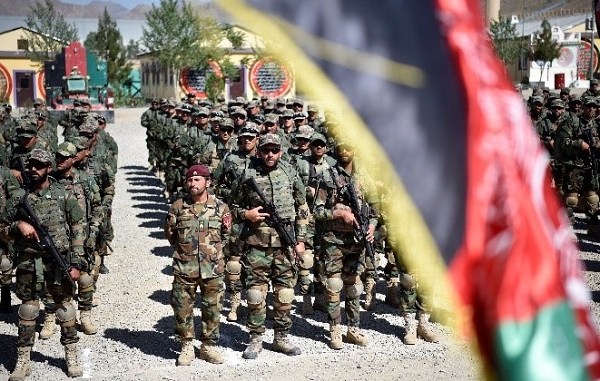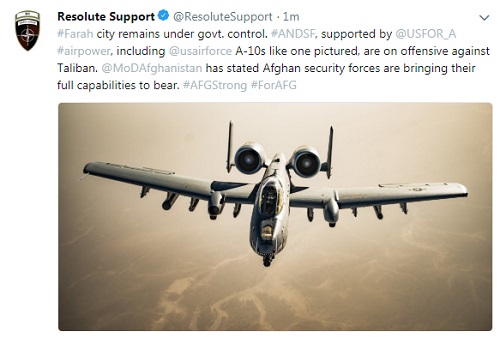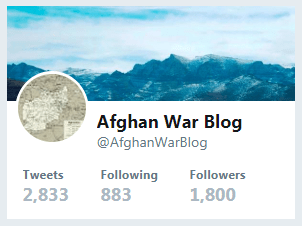
The Taliban’s spring offensive has been underway for almost one month and they have been extremely busy across all parts of Afghanistan. Kabul continues to experience suicide bombing attacks, district centers have been captured (and usually retaken by Afghan SOF), and a few provincial capitals have been threatened (Ghazni, Farah, etc.).
The Afghan Special Security Forces (ASSF) have taken on the Taliban in many battles across the country. Usually the Afghan SOF prevail; especially when their capability is enhanced with U.S. ‘enablers’ (ISR, fires, CAS, etc.).
Found below are a selection of articles over the past week on security, ANDSF, Resolute Support Mission, governance, politics, development, economy, and more.
Security
Costly Helicopter Rides. Rather than drive by armored vehicle along a three-mile stretch of road from the U.S. embassy or Resolute Support Mission compound to the international airport – embassy and military personnel fly by helicopter. Every day the green zone is filled with the constant drone of helicopters landing on and taking off from the soccer field located on the RS compound. Currently the cost for State Department personnel to fly one person one way on that very quick flight is about $1,350. The cost may soon go up to about $2,250 next year. Kind of an indicator of the security situation in Kabul. Read more in “Costly Helicopter Rides for U.S. Officials Show Afghanistan’s Security Decline”, Bloomberg, May 14, 2018.
Taliban Have Initiative. According to analysis by Bill Roggio of the FDD’s Long War Journal the Taliban have taken the initiative way from the ANDSF with its widespread spring offensive that kicked off a month ago. Read “Taliban’s 2018 Offensive Encompasses All Regions of Afghanistan”, Real Clear Defense, May 18, 2018.
Fight for the Districts. The Taliban have been attacking several district centers across the country. Usually they hold the DCs for a couple of days until Afghan SOF can respond and dislodge the insurgents. Recent news reports indicate that over the past week the Daraboom district of Badghis province fell to the Taliban on May 17th. In Ghazni province the districts of Zana Khan, Ajristan, and Jaghatu were under attack. Tala Barfak in Baghlan fell to the Taliban but was retaken by Afghan armed forces on Friday, May 18th. Although news accounts vary it is reported that Afghan security forces have regained control of at least half of the district centers that have fallen in the past week.
Provincial Capitals. Several provincial capitals have come under Taliban threat. The Afghan Ministry of Defense (MoD) has identified Ghazni, Tarin Kot, Kunduz, Pul-e-Khumri, Farah, and Faizabad as under threat. See also Bill Roggio’s piece on this same topic (Threat Matrix, May 17, 2018).
Farah City Attack
A Taliban attack on the provincial capital of Farah on Tuesday, May 15th caused the provincial governor to flee. The insurgents seized check posts and government buildings and were present in the city center. The attack was launched from the rural areas surrounding Farah controlled by the Taliban. Videos depicted Taliban forces in the city square, patrolling around the city, and walking around in daylight in the main bazaar.
Afghan commandos quickly responded to the attack and the Taliban withdrew. News reports say that the Taliban were equipped with night vision goggles and heavy weapons. It would seem that 17 years into the war the Afghan security forces are still relying on U.S. air power to keep a provincial city from falling into the hands of the Taliban. (Reuters, May 15, 2018). Some Afghan officials are casting blame towards Iran – accusing the neighboring country of providing funds and equipment. (VOA, May 17, 2018).

Afghan National Defense
and Security Forces (ANDSF)
Commando Qualification Course. In early May the Afghan Commando Qualification Course (CDOQC) graduated 980 new Commandos at the Afghan National Army Special Operations Command’s School of Excellence at Camp Commando located on the outskirts of Kabul. The CDOQC is a 14-week course designed to assess and train Afghan soldiers for assignment in one of the 10 Special Operations Kandaks (SOKs). Approximately 20 percent of the graduating class attends job specific specialty skill training before departing for their next assignment. The remainder of the class reports directly to their new SOKs. The growth of the Afghan Special Security Forces (Afghan SOF) is a key component of the Afghan 2020 Roadmap. The Roadmap calls for a doubling of the Afghan special operations forces over the next four years. (Info take from “Command Force Grows by 4,000 in 9 Months”, by MSG Felix Figueroa, NATO Special Operations Component Command – Afghanistan (NSOCC-A), May 9, 2018.
International Forces
UK – More Troops? Currently the United Kingdom has about 600 troops in Afghanistan – most involved in staff operations or training Afghan troops in the Kabul area. The UK defence secretary has recommended that the UK boots its military presence in the country – pushing the numbers up to 1,000. Read “Afghanistan: UK considers sending more troops“, BBC News, May 18, 2018.
Video – Gen Nicholson Interviewed. Sue Turton, an Aljazeera correspondent, spent a week at Resolute Support HQs and goes on tour with the Resolute Support Mission commander. Watch a 25-minute long video of an interview with General John Nicholson.
US Airpower Stats for April 2018. U.S. Air Forces Central Command has some interesting statistics posted on their website. The number of weapons released in support of Freedom Sentinel increased to 562 in April; the highest total for any month since January 2013 (five years ago). Much of the air campaign is being directed against revenue-producing activities of the insurgents (that would be the drug trade). More supplies have been airdropped in 2018 than any other year since 2013. (Source is AFCENT airpower summaries).
Profile of a US Citizen-Soldier. A U.S. Army major who works logistics issues at Train, Advise, Assist Command – South is also – in his civilian life – a college professor of molecular genetics and biochemistry. Read “Citizen-Soldier: From professor to CA National Guard Officer”, DVIDS, May 20, 2018.
Governance
New Nangarhar Governor. Hayatullah Hayat has been appointed governor of the eastern province along the Pakistan border. He was previously governor of Helmand province. Nangarhar has been having some significant security issues lately.
ID Card Rollout. The electronic national identity card continues to be issued to Afghan citizens. Some of the ethnic groups are opposed to the term “Afghan” on the card. Protests are continuing in many areas of Afghanistan on this issue.
NATO Workshop on Afghan Governance. A workshop was held to assist Afghanistan in its continuing efforts to build integrity, address corruption, and strengthen transparency and accountability. See “Afghan officials discuss building integrity and good governance”, NATO, May 15, 2018. Hmmmm.
Election Security. Voter registration sites have been targeted by insurgents causing the government to shut down some locations. The parliamentary elections of 2018 and presidential election of 2019 are likely to be disrupted with continuing violence across the country. Read more in “Afghanistan: Securing Elections – Analysis”, Eurasia Review, May 15, 2018.
Development and Economy
Paper on Poppy and the Deserts of SW Afghanistan. Noted author and scholar David Mansfield continues his investigation into the opium trade of Afghanistan in a new paper entitled Still Water Runs Deep: Illicit Poppy and the Transformation of the Deserts of Southwest Afghanistan, May 2018, posted on the website of the Afghanistan Research and Evaluation Unit (AREU).
https://areu.org.af/archives/publication/1808
A Look at Aid Effectiveness in Afghanistan. The folks at Afghanistan Analysts Network explain the findings of two different reports about the effectiveness (and ineffectiveness) of aid projects in Afghanistan. Read “The State of Aid and Poverty in 2018: A new look at aid effectiveness in Afghanistan”, AAN, May 17, 2018.
Peace Talks
AfPak Peace Plan. The Pakistani prime minister and President Ashraf Ghani met in April to agree to make steps towards peace in Afghanistan. The plan is known as the Afghanistan-Pakistan Action Plan for Peace and Solidarity (APAPPS). The two leaders agreed to seven key principles to finalize the action plan. Read more in “Afghanistan-Pakistan Finalize Joint Action Plan for Peace”, Tolo News, May 15, 2018.
VP Dostum on Peace with the Taliban. The exiled vice president, speaking from Ankara, is interviewed by Fox News where he speaks out against efforts to cower to the Taliban as the insurgent group continues to gain ground in Afghanistan. He believes that reconciliation needs to be handled from a position of strength; not one of weakness and appeasement. The colorful warlord says he hopes to return to northern Afghanistan where he can ride on horseback and fight the Taliban in the northern mountains of his homeland (as he was depicted doing in the movie 12 Strong). (Fox News, May 15, 2018).
An Opportunity for Peace? Johnny Walsh, a senior ‘expert’ on Afghanistan at the U.S. Institute of Peace, is focused on the Afghan peace process. He spent 2007-2017 at the State Department working primarily on issues related to Afghanistan. He believes that we should “Seize This Moment for Afghan Peace Talks”, Defense One, May 16, 2018. Another Hmmmm.
Commentary
Political Islam. Adam Azim writes on the cases of the political success of Islamists in Egypt and Afghanistan. Read “Has Political Islam Been a Successful Social and Political Project? Why or Why Not?”, AdamAzim.net, May 17, 2018.
Not Failing. Luke Coffey of The Heritage Foundation provides us with a rosy outlook on the dismal situation in Afghanistan. Read “No, We Have Not Failed in Afghanistan. Here’s Why the US Should Stay”, The Daily Signal, May 16, 2018.
Afghan Generals – A Big Problem. Ihsanullah Omarkahil provides his thoughts on the leadership of the Afghan security forces in “Afghan security sector in dire need of reform”, Asia Times, May 21, 2018.
US Contracting Practices – “Do No Harm”. Grep Kelponis has wrote a paper that takes a close look at one aspect of the overall intervention / stability effort in Afghanistan that many believe is having the opposite effect of that which it is intended. Some U.S. failures in contracting have hurt local Afghan communities and, in addition, the practices by our civilian contract companies have and can actually undo much of the good work that the military has done in Afghanistan. Read “At Least Do No Harm: The Negative Effects and Unforeseen Consequences of US Contracting Practices on the Afghan Local Community and its Influence on the Perception of US Forces and Americans”, Small Wars Journal, 2018.
Upcoming Events
May 24th – Stabilization Event. On May 24th the Center for 21st Century Security and Intelligence will host John F. Sopko of SIGAR for an address on the release of the new SIGAR report titled “Stabilization: Lessons from the U.S. Experience in Afghanistan“. A discussion will follow facilitated by Brookings President John R. Allen (former ISAF cdr). The webcast should be available online. See Stabilization: Lessons From the U.S. Experience in Afghanistan, Brookings.
Twitter Followers. For those who want to follow Afghan war news on Twitter – the Afghan War Blog is a good source.

***
Top Photo: Newly trained Afghan Commandos stand in formation during a graduation ceremony at Camp Commando, Kabul, Afghanistan on May 9, 2018. Photo by U.S. Army MSG Felix Figueroa, NATO Special Operations Component Command – Afghanistan (NSOCC-A), May 9, 2018.